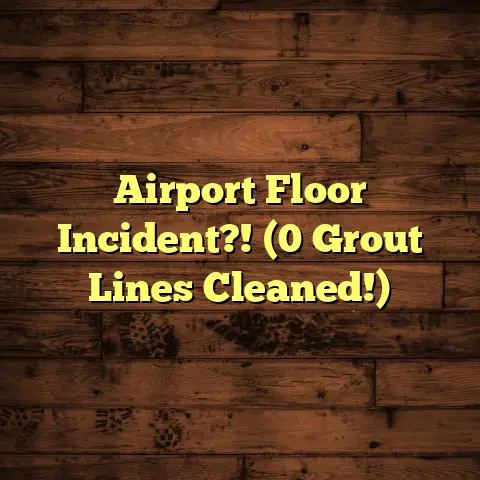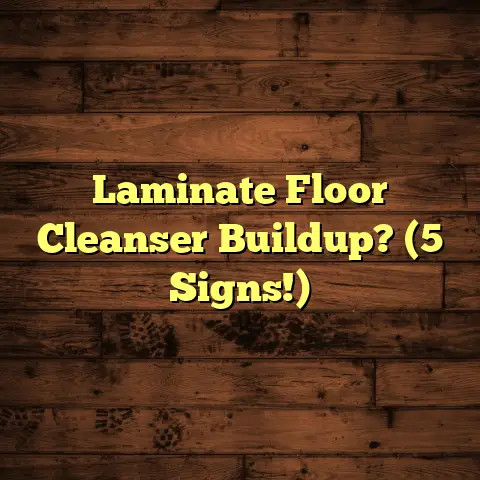Fix Uneven Concrete Patio? (3 Quick Fixes!)
Ever tripped on your patio?
Or noticed your outdoor table wobbling?
An uneven concrete patio isn’t just an eyesore;
it’s a safety hazard and a real mood killer
when you’re trying to enjoy your outdoor space.
Water pooling? Cracks spreading like wildfire? These are signs your patio needs some TLC.
But don’t worry, you don’t need to call in the demolition crew just yet.
I’ve seen it all in my years as a flooring contractor, and I’m here to tell you, fixing an uneven concrete patio doesn’t have to be a massive, wallet-draining project.
In this article, I’m going to walk you through three quick fixes that can breathe new life into your patio, each with its own unique approach and level of DIY-ability.
We’re talking solutions that range from relatively simple to a bit more involved, so you can choose the one that best fits your skills, budget, and the severity of the problem.
Ready to get your patio back on the level? Let’s dive in!
Section 1: Understanding the Causes of
Uneven Concrete Patios
Before we grab our tools and get to work,
it’s crucial to understand why your patio
decided to take a nosedive in the first place.
Knowing the culprit will help you choose
the right fix and prevent the problem
from recurring.
Here’s the lowdown on the usual suspects:
Soil Settlement: This is the big one.
The ground beneath your patio is constantly shifting, settling, and compacting.
Over time, this can cause the concrete to sink unevenly.
Think of it like building a house on sand – eventually, things are going to shift.- Pro Tip: Areas with expansive clay soil are particularly prone to settlement issues.
Tree Roots: Those beautiful trees in your yard can be secret patio saboteurs.
As they grow, their roots can push and lift sections of your concrete, creating cracks and uneven surfaces.Weather Conditions: Mother Nature can be tough on concrete.
Freeze-thaw cycles, where water seeps into cracks, freezes, expands, and then thaws, can wreak havoc.
Repeated cycles lead to cracking and shifting over time.- Fun Fact: According to the American Society of Civil Engineers (ASCE), freeze-thaw cycles are a major cause of concrete deterioration in cold climates.
Improper Installation: Let’s face it, not all concrete jobs are created equal.
If your patio wasn’t properly installed in the first place – think inadequate base preparation, improper drainage, or poor concrete mix – it’s more likely to develop problems down the road.- Personal Story: I once worked on a
patio where the original contractor
hadn’t bothered to compact the soil
before pouring the concrete.
It was a disaster waiting to happen!
- Personal Story: I once worked on a
patio where the original contractor
hadn’t bothered to compact the soil
before pouring the concrete.
Erosion: Rainwater runoff can wash away soil from underneath the concrete slab, leading to voids and uneven settling.
This is especially common if your patio doesn’t have proper drainage.
So, how do these factors affect your patio’s
long-term health?
Well, an uneven surface
isn’t just a cosmetic issue.
It can lead to:
- Water Pooling: Standing water can damage the concrete, promote mold growth, and create slippery surfaces.
- Increased Cracking: Uneven stress on the concrete can accelerate cracking and deterioration.
- Safety Hazards: Tripping hazards are a real concern, especially for children and the elderly.
- Reduced Property Value: A cracked and uneven patio can detract from your home’s curb appeal and overall value.
I remember one client in Denver who had a
beautiful backyard, but the uneven patio made
it unusable.
Water would pool in the low spots,
creating a mosquito breeding ground, and the
cracks were getting worse every year.
After we fixed the patio, they were able to
finally enjoy their outdoor space again.
Understanding the root cause of your uneven
patio is half the battle.
Once you know what
you’re dealing with, you can choose the
right fix and prevent the problem from
coming back.
Now, let’s get to those quick fixes!
Section 2: Quick Fix #1 –
Self-Leveling Compound
Alright, let’s kick things off with a solution that’s perfect for patios with minor unevenness: self-leveling compound.
What is Self-Leveling Compound?
Think of self-leveling compound as a magic
potion for your patio.
It’s a cement-based
mixture that, when mixed with water, creates
a free-flowing liquid that spreads out and
levels itself.
As it dries, it hardens into
a smooth, even surface.
- Composition: Most self-leveling compounds are made from a blend of cement, polymers, and other additives that enhance flow, adhesion, and durability.
- How it Works: The liquid consistency
allows the compound to fill in low spots
and create a level surface under its own
weight.
It’s like pouring pancake batter onto a griddle – it spreads out evenly.
Step-by-Step Application
Here’s how to apply self-leveling compound like a pro:
-
Gather Your Supplies:
- Self-leveling compound (calculate the amount you need based on the area and depth of the unevenness)
- Mixing bucket
- Drill with a mixing paddle
- Spiked roller (to remove air bubbles)
- Level
- Measuring pitcher
- Duct tape or foam weather stripping (to create a dam)
- Concrete primer (optional, but recommended)
- Safety glasses and gloves
Surface Preparation:
- Clean the patio: Remove all dirt, debris, and loose concrete with a stiff brush or pressure washer.
- Repair cracks: Fill any large cracks with concrete patch before applying the self-leveling compound.
- Prime the surface (optional):
Applying a concrete primer will improve
the adhesion of the self-leveling
compound.
Follow the manufacturer’s instructions for application and drying time.
Create a Dam:
- Use duct tape or foam weather stripping
to create a dam around the perimeter of
the area you’re leveling.
This will prevent the self-leveling compound from flowing outside the designated area.
- Use duct tape or foam weather stripping
to create a dam around the perimeter of
the area you’re leveling.
Mixing:
- Read the instructions: This is
crucial!
Each self-leveling compound has specific mixing instructions, including the water-to-powder ratio.
Follow them carefully. - Add water to the bucket: Pour the correct amount of water into the mixing bucket.
- Slowly add the powder: Gradually add the self-leveling compound powder to the water while mixing with a drill and mixing paddle.
-
Mix thoroughly: Mix for the recommended time (usually 2-3 minutes) until you have a smooth, lump-free consistency.
- Warning: Over-mixing can introduce air bubbles, while under-mixing can result in a lumpy, uneven finish.
- Read the instructions: This is
crucial!
-
Pouring:
- Pour carefully: Pour the self-leveling compound onto the patio, starting in the deepest areas.
- Spread evenly: Use a trowel or squeegee to help spread the compound evenly and ensure it fills all the low spots.
Remove Air Bubbles:
- Use a spiked roller: Immediately
after pouring, use a spiked roller to
remove any air bubbles that may be
trapped in the compound.
This will ensure a smooth, durable finish.
- Use a spiked roller: Immediately
after pouring, use a spiked roller to
remove any air bubbles that may be
trapped in the compound.
Drying:
- Allow to dry completely: Let the
self-leveling compound dry completely
according to the manufacturer’s
instructions.
This can take anywhere from 24 to 72 hours, depending on the product and environmental conditions. - Protect from the elements: Protect the drying compound from rain, direct sunlight, and extreme temperatures.
- Allow to dry completely: Let the
self-leveling compound dry completely
according to the manufacturer’s
instructions.
Tips for Best Results
- Determine the Right Thickness: Use a
level to identify the deepest areas of your
patio and calculate the amount of
self-leveling compound you’ll need to fill
them in.
Most self-leveling compounds can be applied in layers up to a certain thickness, so check the manufacturer’s specifications. - Temperature and Humidity: Ideal
application conditions are typically
between 50°F and 80°F with low humidity.
Avoid applying self-leveling compound in extreme temperatures or during periods of high humidity, as this can affect the drying time and the final finish. - Work in Sections: If you have a large patio, consider working in smaller sections to ensure that the self-leveling compound doesn’t start to dry before you’ve had a chance to spread it evenly.
- Clean Your Tools: Clean your mixing bucket, drill, and other tools immediately after use to prevent the self-leveling compound from hardening on them.
Real-Life Examples
I’ve seen homeowners transform their patios
with self-leveling compound.
One client in
Austin, Texas, had a patio with several
shallow dips and cracks.
She was able to
easily apply self-leveling compound herself,
and the results were amazing.
The patio
looked brand new, and she was thrilled with
the smooth, even surface.
Another homeowner I know used self-leveling
compound to fix a sloping patio that was
causing water to run towards the house.
By leveling the patio, he was able to
redirect the water away from the foundation
and prevent further damage.
Limitations
While self-leveling compound is a great
solution for minor unevenness, it’s not a
miracle cure.
Here are some limitations to
consider:
- Depth: Self-leveling compound is
typically only effective for filling in
shallow depressions (usually less than
1-2 inches).
If your patio has significant elevation changes, you’ll need a different solution. - Cost: Self-leveling compound can be relatively expensive, especially if you need to apply multiple layers.
- Surface Condition: If your patio is severely cracked or damaged, you may need to repair it before applying self-leveling compound.
Section 3: Quick Fix #2 –
Concrete Resurfacer
If your patio is showing its age with cracks, minor unevenness, and a generally worn-out appearance, concrete resurfacer might be just what you need.
What is Concrete Resurfacer?
Concrete resurfacer is a polymer-modified
cement overlay that’s designed to be applied
over existing concrete surfaces.
It’s like
giving your patio a facelift – it covers up
imperfections and creates a fresh, new surface.
- How it Differs from Self-Leveling
Compound: While self-leveling compound
is primarily used to level uneven surfaces,
concrete resurfacer is more versatile.
It can be used to level minor imperfections, but it also provides a new, durable surface that can hide cracks, stains, and other cosmetic flaws.
Step-by-Step Instructions
Here’s how to apply concrete resurfacer for a stunning patio transformation:
-
Gather Your Supplies:
- Concrete resurfacer
- Mixing bucket
- Drill with a mixing paddle
- Trowel or squeegee
- Concrete primer
- Pressure washer
- Concrete patch (for repairing cracks)
- Painter’s tape
- Safety glasses and gloves
Surface Preparation:
- Clean the patio: Thoroughly clean the patio with a pressure washer to remove all dirt, debris, and loose concrete.
- Repair cracks: Fill any cracks with concrete patch and allow it to dry completely.
- Etch the surface: Etch the concrete
surface with a concrete etcher or muriatic
acid to improve adhesion.
Follow the manufacturer’s instructions carefully and wear appropriate safety gear. - Rinse thoroughly: Rinse the patio thoroughly with water to remove all traces of the etcher.
- Allow to dry: Allow the patio to dry completely before applying the concrete resurfacer.
Prime the Surface:
- Apply a concrete primer to the patio
surface to improve adhesion.
Follow the manufacturer’s instructions for application and drying time.
- Apply a concrete primer to the patio
surface to improve adhesion.
-
Mixing:
- Read the instructions: As with self-leveling compound, it’s crucial to follow the manufacturer’s mixing instructions carefully.
- Add water to the bucket: Pour the correct amount of water into the mixing bucket.
- Slowly add the powder: Gradually add the concrete resurfacer powder to the water while mixing with a drill and mixing paddle.
- Mix thoroughly: Mix for the recommended time until you have a smooth, lump-free consistency.
-
Application:
- Apply a thin coat: Use a trowel or squeegee to apply a thin, even coat of concrete resurfacer to the patio surface.
- Work in sections: If you have a large patio, work in smaller sections to ensure that the resurfacer doesn’t start to dry before you’ve had a chance to spread it evenly.
- Create texture (optional): You can create different textures by using a broom, sponge, or other tools to add patterns to the wet resurfacer.
Curing:
- Keep it moist: Cover the resurfaced
patio with plastic sheeting or spray it
with water periodically to keep it moist
during the curing process.
This will help prevent cracking and ensure a strong, durable finish. - Allow to cure completely: Allow the
resurfacer to cure completely according
to the manufacturer’s instructions.
This can take several days.
- Keep it moist: Cover the resurfaced
patio with plastic sheeting or spray it
with water periodically to keep it moist
during the curing process.
Types of Resurfacing Products
There are many different types of concrete resurfacing products available, each with its own pros and cons:
- Acrylic-Modified Cement Overlays: These
are a good all-around choice for patios
with minor imperfections.
They’re durable, easy to apply, and relatively affordable. - Polymer-Modified Cement Overlays: These offer superior strength and durability, making them a good choice for patios that experience heavy traffic or harsh weather conditions.
- Epoxy Coatings: Epoxy coatings are
extremely durable and resistant to stains
and chemicals.
They’re a good choice for patios that are used for grilling or outdoor dining.
Before-and-After Transformations
I’ve seen some incredible patio transformations
with concrete resurfacer.
One client in
Phoenix, Arizona, had a patio that was
covered in cracks and stains.
After applying
concrete resurfacer, the patio looked brand
new.
It was a complete transformation!
Another homeowner I know used concrete
resurfacer to create a decorative stamped
concrete patio.
He used stencils and stamps
to create a beautiful pattern in the wet
resurfacer, and the results were stunning.
Durability and Maintenance
A properly applied concrete resurfacer can
last for many years with proper maintenance.
Here are some tips for keeping your
resurfaced patio looking its best:
- Seal the surface: Apply a concrete sealer to protect the resurfacer from stains and water damage.
- Clean regularly: Clean the patio regularly with a mild detergent and water.
- Avoid harsh chemicals: Avoid using harsh chemicals or abrasive cleaners, as these can damage the resurfacer.
- Repair cracks promptly: Repair any cracks that develop promptly to prevent water from seeping underneath the resurfacer.
Section 4: Quick Fix #3 – Mudjacking
When your concrete patio has taken a serious nosedive – we’re talking significant sinking and elevation changes – it’s time to bring in the big guns: mudjacking.
What is Mudjacking?
Mudjacking, also known as slab jacking or
piering, is a technique used to raise sunken
concrete slabs back to their original level.
It involves pumping a slurry of mud-like
material under the slab to lift it up.
-
The Process:
- Drilling Holes: Small holes (usually 2-3 inches in diameter) are drilled through the concrete slab.
- Pumping the Slurry: A mixture of mud, cement, and other materials is pumped through the holes under the slab.
- Lifting the Slab: As the slurry fills the void beneath the slab, it lifts the concrete back to its original level.
- Patching the Holes: The holes are then patched with concrete.
Hiring a Professional
Mudjacking is not a DIY project.
It requires
specialized equipment and expertise.
Here’s
how to hire a professional mudjacking
contractor:
- Get Multiple Quotes: Contact several mudjacking contractors and get written quotes.
- Check References: Ask for references from previous clients and check them carefully.
- Verify Licensing and Insurance: Make sure the contractor is licensed and insured.
- Ask About Experience: Choose a contractor with experience in mudjacking concrete patios.
- Get a Detailed Contract: Make sure the contract includes a detailed description of the work to be performed, the materials to be used, and the total cost.
Questions to Ask
Here are some questions to ask potential mudjacking contractors:
- How long have you been in business?
- Do you have experience mudjacking concrete patios?
- What type of slurry do you use?
- How many holes will you need to drill?
- How will you ensure that the slab is lifted evenly?
- What is your warranty?
What to Expect
Here’s what to expect during the mudjacking process:
- Noise: The mudjacking equipment can be noisy.
- Mess: There may be some mess associated with the drilling and pumping process.
- Time: The mudjacking process can take several hours, depending on the size of the patio and the extent of the sinking.
- Curing Time: The concrete patch will need to cure for several days before you can use the patio.
Case Studies
I’ve seen mudjacking completely transform
severely sunken patios.
One client in Kansas
City had a patio that had sunk several inches
in one corner.
After mudjacking, the patio
was perfectly level and looked like new.
Another homeowner I know had a patio that
was cracked and uneven due to tree roots.
The mudjacking contractor was able to lift
the patio and fill the voids created by the
roots, restoring the patio to its original
condition.
Misconceptions
There are some common misconceptions about mudjacking:
- It’s only a temporary fix: While mudjacking is not a permanent solution, it can last for many years if done properly.
- It will damage my patio: When done correctly, mudjacking will not damage your patio.
- It’s too expensive: Mudjacking is often more affordable than replacing the entire patio.
Conclusion
So, there you have it – three quick fixes for
an uneven concrete patio!
We’ve covered
everything from the magic of self-leveling
compound to the transformative power of
concrete resurfacer and the heavy-duty
lifting capabilities of mudjacking.
Remember, a level concrete patio isn’t just
about aesthetics; it’s about safety and
enjoyment.
An uneven surface can lead to
tripping hazards, water pooling, and
accelerated deterioration.
Take a good look at your patio.
Assess the
severity of the problem, your DIY skills,
and your budget.
Choose the solution that
best fits your needs.
Whether you decide to tackle it yourself or hire a professional, taking action to fix your uneven patio will transform your outdoor space into a safe, enjoyable, and beautiful environment.
Now go out there and get your patio back on the level!





